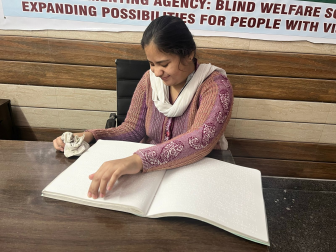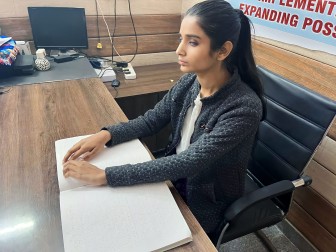In a world where accessibility and inclusion are essential for building a fair and equitable society, it’s crucial to ensure that visually impaired individuals receive the care and resources they need to lead independent, healthy lives. Visual impairment is a condition that affects millions globally, and it goes beyond just physical limitations. It can impact every aspect of a person’s life, from employment to education, mobility, and social interactions. However, creating inclusive care for visually impaired people can help eliminate many of these barriers, ensuring they have the support and tools to thrive.
Visual impairment can range from mild vision loss to complete blindness. According to the World Health Organization (WHO), over 2.2 billion people worldwide suffer from some form of visual impairment, with many living in low and middle-income countries where access to resources is limited. This highlights the need for widespread initiatives and resources dedicated to helping these individuals live better lives.
Visual impairment often leads to challenges in accessing healthcare, education, and employment. It is critical that society acknowledges these challenges and works to create an environment that fosters independence, inclusion, and accessibility.
Inclusive care is about designing and providing services that cater to the specific needs of individuals with visual impairments. It means more than just physical accessibility—it involves ensuring that visually impaired people have the tools, resources, and support they need to navigate the world confidently. Here are a few key reasons why inclusive care is vital for a healthier world:
Promoting Independence and Autonomy
When visually impaired individuals have access to the right resources, they can lead more independent lives. Technologies like screen readers, Braille devices, and audio-based apps enable people to interact with the world in new ways, making daily tasks more manageable. This empowerment leads to greater autonomy, which is essential for improving mental health and overall well-being.
Improving Healthcare Accessibility
Visually impaired individuals face barriers to accessing proper healthcare, from difficulties navigating medical facilities to challenges in reading labels and prescriptions. Ensuring healthcare providers offer accessible services, such as audio consultations, Braille information, or text-to-speech options, can significantly improve the healthcare experience for visually impaired patients.
Advancing Education and Employment Opportunities
Access to education and employment opportunities is crucial for empowering visually impaired people. By providing accessible learning materials, assistive technologies, and tailored support, educational institutions can create environments where visually impaired individuals can succeed. Similarly, workplace inclusivity policies and adaptive technologies allow them to participate in the workforce on equal terms, thus enhancing their financial independence and societal contribution.
Enhancing Social Integration
Social isolation is a significant issue for many visually impaired people, as they may find it harder to engage in social activities, travel independently, or form relationships. Creating spaces and programs that promote social inclusion—such as community events with accessibility features, support groups, and recreational programs—helps improve their quality of life and reduces the sense of isolation.
There are numerous resources available to help visually impaired individuals live healthier, more fulfilling lives. These resources range from technology to community support networks, and they play a key role in creating inclusive care. Here are some vital resources that make a real difference:
Assistive Technologies
Support Organizations & Advocacy Groups
Organizations such as the American Foundation for the Blind (AFB) and the Royal National Institute of Blind People (RNIB) provide vital advocacy, education, and support services to help visually impaired individuals access resources, learn new skills, and engage with the community. These organizations also work to raise awareness and advocate for better accessibility in public spaces and services.
Braille & Audio Resources
Braille books, audio books, and accessible digital content are essential for visually impaired people to access information, education, and entertainment. Libraries for the blind, such as the National Library Service for the Blind and Print Disabled (NLS), offer a vast array of free Braille and audio books to support lifelong learning.
Healthcare Services Specializing in Visual Impairment
Specialized eye care professionals and rehabilitation centers can help visually impaired individuals manage their condition, improve mobility, and gain the skills needed to live independently. Many centers also offer therapy services, including training in mobility techniques and daily living skills.
Inclusive Workplaces and Educational Institutions
Companies and schools that embrace inclusive practices—such as offering Braille documents, ensuring accessible websites, and providing assistive technologies—help create equal opportunities for visually impaired individuals. In education, specialized schools or programs for visually impaired students provide tailored learning experiences, while inclusive workspaces foster greater workplace participation.
Creating inclusive care for visually impaired people is not only about addressing their physical needs but also about breaking down social, economic, and technological barriers. By investing in resources, technology, and inclusive practices, we can help visually impaired individuals lead healthier, more fulfilling lives. Whether through assistive technologies, accessible healthcare, or supportive community services, creating a world that is accessible to all is an essential step toward a more just and compassionate society.
Together, we can build a healthier, more inclusive world—one where no one is left behind.
By contributing to our feature donation campaigns, you are not just supporting us,
you are fostering independence, education, and accessibility for the people with blindness.
We are providing free shelter, food and educational support to the abandoned visually impaired girls residing at BWS.
₹1146562
raised of ₹2000000 Goal
57%
1 Days left
573 Supporters
Maa and Papa weren’t the happiest when I was born. They thought I was a burden to them.
₹768833
raised of ₹2000000 Goal
38%
1 Days left
589 Supporters
The Walking Canes have proved a useful tool to millions of blind people in navigating their environments with confidence and ease.
At our organization, we provide a nurturing environment for visually impaired girls, helping them lead fulfilling lives despite their challenges.
The following stories highlight the transformative journey of these remarkable individuals within our organization.

Hailing from Delhi, Sneha came to Blind Welfare Society in July 2023.
.jpeg)
Hailing from a small village of Gwalior district, Madhya Pradesh, Archana came to Blind Welfare Society in July 2023

Chhavi’s journey is a testament to the transformative power of education and the invaluable support provided by the Blind Welfare Society.